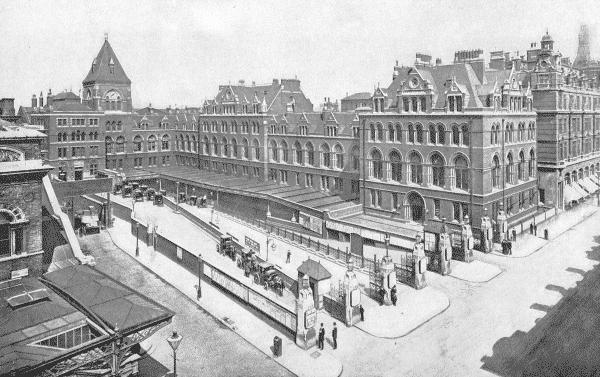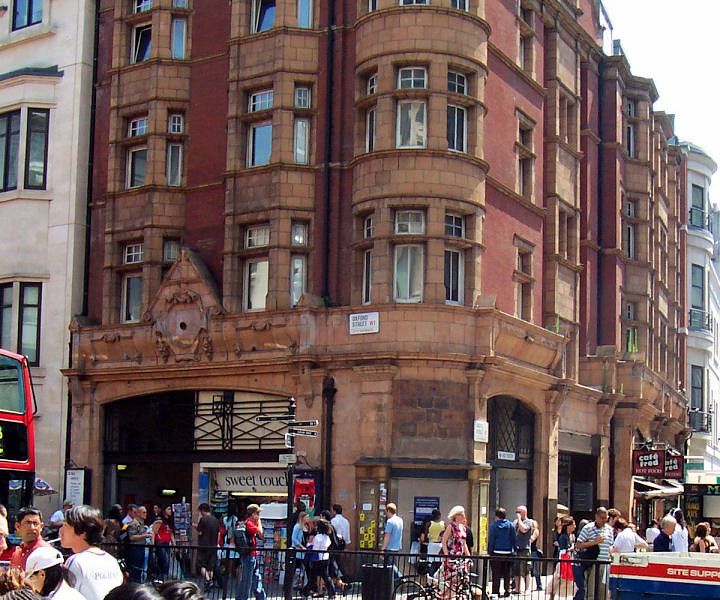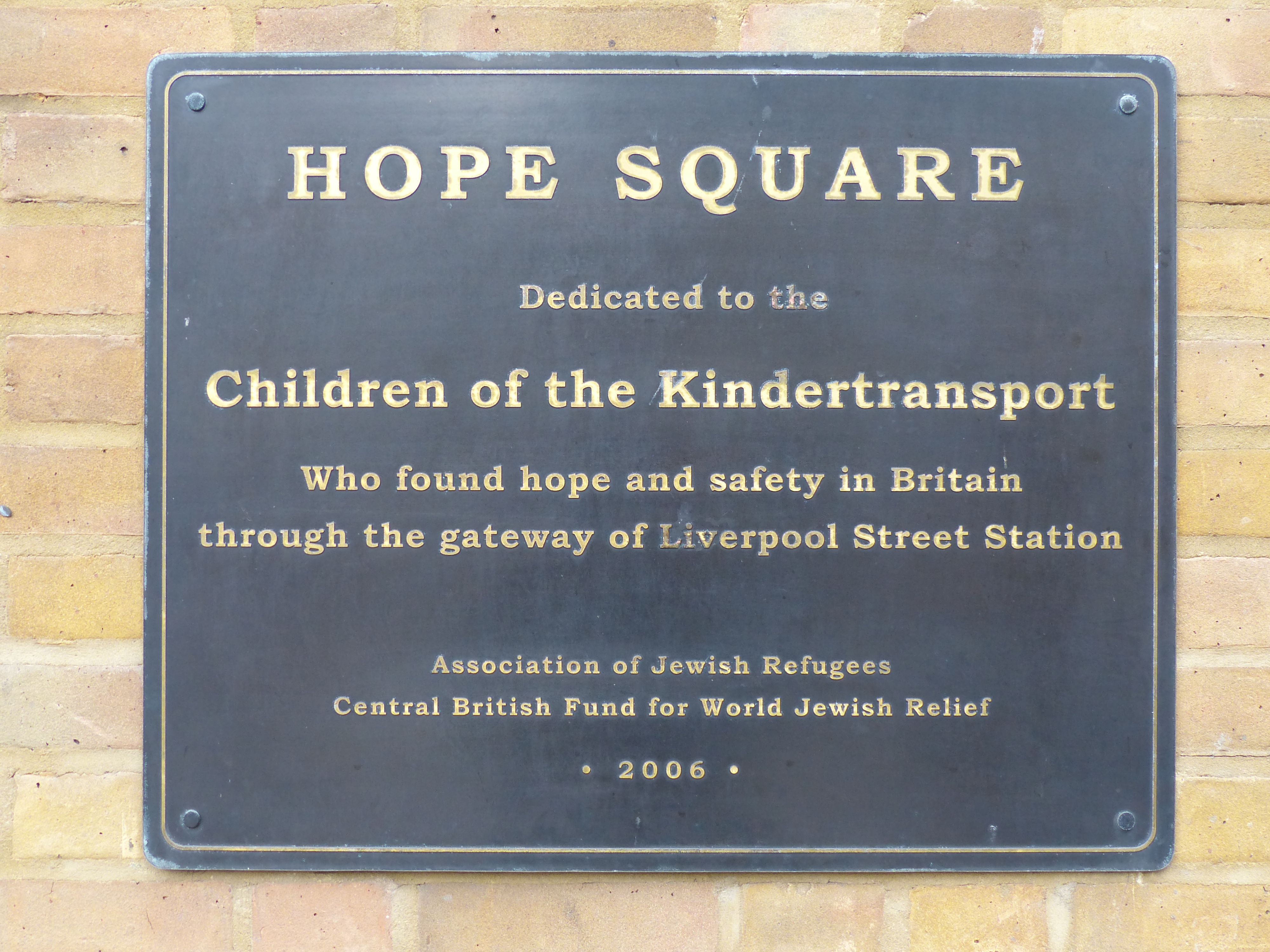|
Liverpool Street Station
Liverpool Street station, also known as London Liverpool Street, is a major central London railway terminus and connected London Underground station in the north-eastern corner of the City of London, in the ward of Bishopsgate Without. It is the terminus of the West Anglia Main Line to Cambridge and Ely; the Great Eastern Main Line to Norwich; commuter trains serving east London and destinations in the East of England, including the Weaver line of the London Overground; and the Stansted Express service to Stansted Airport. The station opened in 1874, as a replacement for Bishopsgate station as the Great Eastern Railway's main London terminus. By 1895, it had the most platforms of any London terminal station. During the First World War, an air raid on the station killed 16 on site, and 146 others in nearby areas. In the build-up to the Second World War, the station served as the entry point for thousands of child refugees arriving in London as part of the '' Kindertran ... [...More Info...] [...Related Items...] OR: [Wikipedia] [Google] [Baidu] |
Elizabeth Line
The Elizabeth line is a railway line that runs across Greater London and nearby towns, operating similarly to the Réseau Express Régional, RER in Paris and the S-Bahn systems of German-speaking countries. It runs services on dedicated infrastructure in central London from the Great Western Main Line west of London Paddington station, Paddington station to and via Whitechapel station, Whitechapel to the Great Eastern Main Line near ; along the Great Western Main Line to and Heathrow Airport in the west; and along the Great Eastern Main Line to in the east. Under the project name of Crossrail, the system was approved in 2007, and construction began in 2009. Originally planned to open in 2018, the project was repeatedly delayed, including for several months as a result of the COVID-19 pandemic in England, COVID-19 pandemic. The service is now named after Elizabeth II, Queen Elizabeth II, who Opening ceremony, officially opened the line on 17 May 2022 during Platinum Jubilee ... [...More Info...] [...Related Items...] OR: [Wikipedia] [Google] [Baidu] |
Network Rail
Network Rail Limited is the owner (via its subsidiary Network Rail Infrastructure Limited, which was known as Railtrack plc before 2002) and railway infrastructure manager, infrastructure manager of most of the railway network in Great Britain. Network Rail is a non-departmental public body of the Department for Transport with no shareholders, which reinvests its income in the railways. Network Rail's main customers are the private train operating company, train operating companies (TOCs), responsible for passenger transport, and freight operating company, freight operating companies (FOCs), who provide train services on the infrastructure that the company owns and maintains. Since 1 September 2014, Network Rail has been classified as a "public sector body". To cope with history of rail transport in Great Britain 1995 to date, rapidly increasing passenger numbers, () Network Rail has been undertaking a £38 billion History of rail transport in Great Britain 1995 to date#Timelin ... [...More Info...] [...Related Items...] OR: [Wikipedia] [Google] [Baidu] |
London Overground
London Overground (also known simply as the Overground) is a Urban rail in the United Kingdom, suburban rail network serving London and its environs. Established in 2007 to take over Silverlink Metro routes, it now serves a large part of Greater London as well as Hertfordshire, with 113 stations on the six lines that make up the network. The Overground forms part of the United Kingdom's National Rail network but it is under the Rail franchising in Great Britain#Concessions, concession control and branding of Transport for London (TfL). Operation has been contracted to Arriva Rail London since 2016. TfL previously assigned orange as a mode-specific colour for the Overground in branding and publicity including the Roundel (London Transport), roundel, on the Tube map, trains and stations. In 2024, each of the six Overground lines were given distinct colours and names – Lioness line, Lioness, Mildmay line, Mildmay, Windrush line, Windrush, Weaver line, Weaver, Suffragette line, ... [...More Info...] [...Related Items...] OR: [Wikipedia] [Google] [Baidu] |
Circle Line (London Underground)
The Circle line is a spiral-shaped London Underground line, running from Hammersmith in the west to Edgware Road and then looping around central London back to Edgware Road. The railway is below ground in the central section and on the loop east of Paddington. Unlike London's deep-level lines, the Circle line tunnels are just below the surface and are of similar size to those on British main lines. Printed in yellow on the Tube map, the line serves 36 stations, including most of London's main line termini. Almost all of the route, and all the stations, are shared with one or more of the three other sub-surface lines, namely the District, Hammersmith & City and Metropolitan lines. On the Circle and Hammersmith & City lines combined, over 141 million passenger journeys were recorded in 2019. The first section became operational in 1863 when the Metropolitan Railway opened the world's first underground line between Paddington and with wooden carriages and steam locomot ... [...More Info...] [...Related Items...] OR: [Wikipedia] [Google] [Baidu] |
Central Line (London Underground)
The Central line is a London Underground line that runs between or in the west, and or Hainault Loop, Woodford via Hainault in the north-east, via the West End of London, West End, City of London, the City, and the East End of London, East End. Printed in red on the Tube map, the line serves 49 stations over , making it the network's longest line. It is one of only two lines on the Underground network to cross the Greater London boundary, the other being the Metropolitan line. One of London's London Underground infrastructure#Sub-surface network and deep-level tube lines, deep-level railways traversing narrow tunnels, Central line trains are smaller than those on British main lines. The line was opened as the Central London Railway in 1900, crossing central London on an east–west axis along the central shopping street of Oxford Street to the financial centre of the City of London. It was later extended to the western suburb of Ealing. In the 1930s, plans were created to expa ... [...More Info...] [...Related Items...] OR: [Wikipedia] [Google] [Baidu] |
Metropolitan Railway
The Metropolitan Railway (also known as the Met) was a passenger and goods railway that served London from 1863 to 1933, its main line heading north-west from the capital's financial heart in the City to what were to become the Middlesex suburbs. Its first line connected the main-line railway termini at , , and King's Cross to the City. The first section was built beneath the New Road using cut-and-cover between Paddington and King's Cross and in tunnel and cuttings beside Farringdon Road from King's Cross to near Smithfield, near the City. It opened to the public on 10 January 1863 with gas-lit wooden carriages hauled by steam locomotives, the world's first passenger-carrying designated underground railway. The line was soon extended from both ends, and northwards via a branch from Baker Street. Southern branches, directly served, reached Hammersmith in 1864, Richmond in 1877 and the original completed the '' Inner Circle'' in 1884. The most important route was nort ... [...More Info...] [...Related Items...] OR: [Wikipedia] [Google] [Baidu] |
Crossrail
Crossrail is a completed railway project centred on London. It provides a high-frequency hybrid commuter rail and rapid transit system, akin to the Réseau Express Régional, RER in Paris and the S-Bahn systems of German-speaking countries, known as the Elizabeth line, that crosses the capital from suburbs on the west to east and connects two major railway lines terminating in London: the Great Western Main Line and the Great Eastern Main Line. The project was approved in 2007, and construction began in 2009 on the central section and connections to existing lines that became part of the route, which has been named the Elizabeth line in honour of Queen Elizabeth II who opened the line on 17 May 2022 during Platinum Jubilee of Elizabeth II, her Platinum Jubilee. The central section of the line between Paddington Station, Paddington and Abbey Wood railway station, Abbey Wood opened on 24 May 2022, with 12 trains per hour running in each direction through the core section in Centra ... [...More Info...] [...Related Items...] OR: [Wikipedia] [Google] [Baidu] |
7 July 2005 London Bombings
The 7 July 2005 London bombings, also referred to as 7/7, were a series of four co-ordinated suicide attacks carried out by Islamist terrorists that targeted commuters travelling on Transport in London, London's public transport during the morning rush hour. Three terrorists separately detonated three homemade bombs in quick succession aboard London Underground trains in Inner London. Later, a fourth terrorist detonated another bomb on a double-decker bus in Tavistock Square. The train bombings occurred on the Circle line (London Underground), Circle Line near and at Edgware Road tube station (Circle, District and Hammersmith & City lines), Edgware Road, and on the Piccadilly Line near . Apart from the bombers, 52 people of 18 different nationalities were killed and nearly 800 were injured in the attacks. It was the UK's deadliest terrorist incident since the 1988 bombing of Pan Am Flight 103 near Lockerbie, and the UK's first Islamist suicide attack. The explosions were ... [...More Info...] [...Related Items...] OR: [Wikipedia] [Google] [Baidu] |
1993 Bishopsgate Bombing
The Bishopsgate bombing occurred on 24 April 1993, when the Provisional Irish Republican Army (IRA) detonated a powerful truck bomb on Bishopsgate, a major thoroughfare in London's financial district, the City of London. Telephoned warnings were sent about an hour beforehand, but a news photographer was killed in the blast and 44 people were injured, with fatalities minimised due to its occurrence on a Saturday. The blast destroyed the nearby St Ethelburga's church and wrecked Liverpool Street station and the NatWest Tower. As a result of the bombing, which happened just over a year after the bombing of the nearby Baltic Exchange, a " ring of steel" was implemented to protect the City, and many firms introduced disaster recovery plans in case of further attacks or similar disasters. million (equivalent to £ million in ) was spent on repairing damage. In 1994 detectives believed they knew the identities of the IRA bombers, but lacked sufficient evidence to arrest th ... [...More Info...] [...Related Items...] OR: [Wikipedia] [Google] [Baidu] |
Kindertransport
The ''Kindertransport'' (German for "children's transport") was an organised rescue effort of children from Nazi Nazism (), formally named National Socialism (NS; , ), is the far-right politics, far-right Totalitarianism, totalitarian socio-political ideology and practices associated with Adolf Hitler and the Nazi Party (NSDAP) in Germany. During H ...-controlled territory that took place in 1938–1939 during the nine months prior to the outbreak of the Second World War. The United Kingdom took in nearly 10,000 children, most of them Jewish, from Nazi Germany, Germany, Austria under National Socialism, Austria, First Czechoslovak Republic, Czechoslovakia, Second Polish Republic, Poland, and the Free City of Danzig. The children were placed in British foster homes, hostels, schools, and farms. Often they were the only members of their families who survived the Holocaust. The programme was supported, publicised, and encouraged by the British government, which waiv ... [...More Info...] [...Related Items...] OR: [Wikipedia] [Google] [Baidu] |
World War II
World War II or the Second World War (1 September 1939 – 2 September 1945) was a World war, global conflict between two coalitions: the Allies of World War II, Allies and the Axis powers. World War II by country, Nearly all of the world's countries participated, with many nations mobilising all resources in pursuit of total war. Tanks in World War II, Tanks and Air warfare of World War II, aircraft played major roles, enabling the strategic bombing of cities and delivery of the Atomic bombings of Hiroshima and Nagasaki, first and only nuclear weapons ever used in war. World War II is the List of wars by death toll, deadliest conflict in history, causing World War II casualties, the death of 70 to 85 million people, more than half of whom were civilians. Millions died in genocides, including the Holocaust, and by massacres, starvation, and disease. After the Allied victory, Allied-occupied Germany, Germany, Allied-occupied Austria, Austria, Occupation of Japan, Japan, a ... [...More Info...] [...Related Items...] OR: [Wikipedia] [Google] [Baidu] |
World War I
World War I or the First World War (28 July 1914 – 11 November 1918), also known as the Great War, was a World war, global conflict between two coalitions: the Allies of World War I, Allies (or Entente) and the Central Powers. Fighting took place mainly in European theatre of World War I, Europe and the Middle Eastern theatre of World War I, Middle East, as well as in parts of African theatre of World War I, Africa and the Asian and Pacific theatre of World War I, Asia-Pacific, and in Europe was characterised by trench warfare; the widespread use of Artillery of World War I, artillery, machine guns, and Chemical weapons in World War I, chemical weapons (gas); and the introductions of Tanks in World War I, tanks and Aviation in World War I, aircraft. World War I was one of the List of wars by death toll, deadliest conflicts in history, resulting in an estimated World War I casualties, 10 million military dead and more than 20 million wounded, plus some 10 million civilian de ... [...More Info...] [...Related Items...] OR: [Wikipedia] [Google] [Baidu] |











